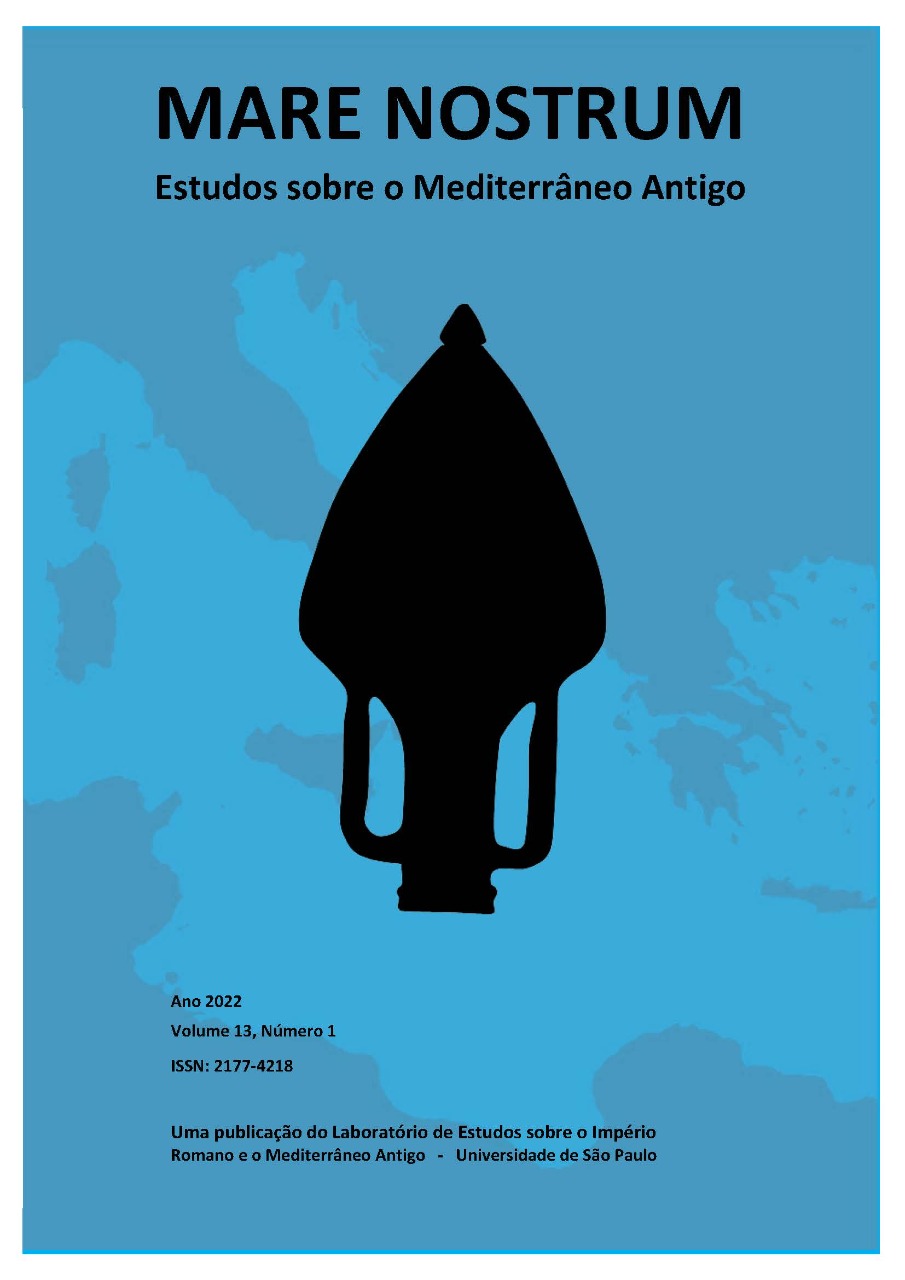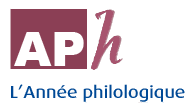Entre Egito e Azania: Conexões Afro-Asiáticas a partir do Périplo do Mar Eritreu
DOI:
https://doi.org/10.11606/issn.2177-4218.v13i1p123-145Palavras-chave:
périplo do mar eritreu, África, história global, AzaniaResumo
Este artigo tem por objetivo analisar os processos de contato e integração entre o nordeste africano e diferentes regiões da África e da Ásia, a partir, especificamente, de um texto anônimo do século I d.C. conhecido como Périplo do Mar Eritreu. Este documento, geralmente lido a partir de uma perspectiva romanocêntrica, será interpretado com base nos modelos analíticos da História Global. Com isso, espera-se mostrar que os portos egípcios do Mar Vermelho faziam parte de um ancestral sistema conectivo afro-asiático – do qual o Império Romano não foi o criador, mas sim um participante tardio.
Downloads
Referências
Fontes Primárias
Burstein, S. (Ed.). (1989). Agatharchides of Cnidus, on the Erythraean Sea. The Hakluyt Society.
Casson, L. (Ed.). (1989). The Periplus Maris Erythraei: Text with Introduction, Translation, and Commentary. Princeton University Press.
Figuras
Figura 1: PHGCOM (2007). Locations, names and routes of the Periplus of the Erythraean Sea (1st century CE). Wikimedia Commons sob licença GNU Free Documentation License. https://commons.wikimedia.org/wiki/File:Map_of_the_Periplus_of_the_Erythraean_Sea.jpg. Acessado em 05/06/2022.
Figuras 2: Bernhard, Hans (1976). Ägyptische Expedition nach Punt während der Regierung von Hatschepsut. Wikimedia Commons sob licença GFDL-CC-BY-SA-all. https://commons.wikimedia.org/wiki/File:Punt2.JPG. Acessado em 05/06/2022.
Figuras 3: Seland, E. H. (2016). The Periplus of the Erythraean Sea: A Network Approach. Asian Review of World Histories, 4(2), p. 191-205. DOI:10.12773/arwh.2016.4.2.191.
Figura 4: Seland, E. H. (2016). The Periplus of the Erythraean Sea: A Network Approach. Asian Review of World Histories, 4(2), p. 191-205. DOI:10.12773/arwh.2016.4.2.191.
Bibliografia Crítica
‛Abdullah, Y. M. (1995). The City of al-Sawā in the Periplus of the Erythraean Sea. Arabian Archaeology and Epigraphy, 6(4), p. 259-269.
Arnaud, P. (2012). Le Periplus Maris Erythraei: une oeuvre de compilation aux préoccupations géographiques. Topoi. Oriente-Occident, 11, p. 26-61.
Balanda, S. (2006). The so-called “Mine of Punt” and its Location. Journal of the American Research Center in Egypt, 42, p. 33-44.
Bard, Kathryn A. & Fattovich, Rodolfo. (2018). Seafaring expeditions to Punt in the Middle Kingdom: Excavations at Mersa/Wadi Gawasis, Egypt. Brill.
Bard, K. A. & Fattovich, R. (2013). In S. Chrisomalis & A. Costopoulos (Eds.). Human Expeditions, Inspired by Bruce Trigger (pp. 3-11). University of Toronto Press.
Bradbury, L. (1996). Kpn-boats, Punt Trade, and a Lost Emporium. Journal of the American Research Center in Egypt, 33, p. 37-60. DOI: 10.2307/40000604.
Brozyna, J. M. (1999). The Incense Route: a Study of its Origin and Development [Dissertação de mestrado não publicada]. San Jose State University.
Cassol, L. (1986). The location of Tabai (Periplus Maris Erythraei 12–13). The Journal of Hellenic Studies, 106, p. 179–182. DOI: 10.2307/629652
Chami, F. A., & Msemwa, P. J. (1997). A New Look at Culture and Trade on the Azanian Coast. Current Anthropology, 38(4), p. 673–677. DOI:10.1086/204654.
Conrad, S. (2019). O que é História Global?. Edições 70.
Contenson, H. (2010). A cultura pré-axumita. In G. Mokhtar (Ed.). História Geral da África II: África Antiga (pp. 351-374). UNESCO.
Creasman, P. P. (2014). Hatshepsut and the Politics of Punt. African Archaeological Review, 31(3), p. 395–405. DOI: 10.1007/s10437-014-9160-9
Datoo, B. A. (1970). Rhapta: the Location and Importance of East Africa’s first Port. Azania: Archaeological Research in Africa, 5(1), p. 65–75. DOI: 10.1080/00672707009511528
Fillafer, F. L. (2017). A world connecting? From the unity of History to Global History. History and Theory, 56(1), p. 3–37. DOI: 10.1111/hith.12000
García, J. C. M. (2016). Trade and Power in Ancient Egypt: Middle Egypt in the Late Third/Early Second Millennium BC. Journal of Archaeological Research, 25, p. 87-132.
Hikade, T. (2006). Expeditions to the Wadi Hammamat during the New Kingdom. The Journal of Egyptian Archaeology, 92(1), p. 153–168. DOI: 10.1177/030751330609200105.
Horton, M. (1990). The Periplus and East Africa. Azania: Archaeological Research in Africa, 25(1), p. 95–99. DOI: 10.1080/00672709009511414.
Huang, H. The Route of Lapis Lazuli: Lapis Lazuli Trade from Afghanistan to Egypt during Mid-Late Bronze Age. Advances in Social Science, Education and Humanities Research (ASSEHR), 183, p. 391-399.
Júnior, J. J. G. dos S. & Sochaczewski, M. (2017) História global: um empreendimento intelectual em curso. Revista Tempo, 23(3), p. 482-502. DOI: 10.1590/TEM-1980-542X2017v230304.
Kirwan, L. P. (1986). Rhapta, Metropolis of Azania. Azania: Archaeological Research in Africa, 21(1), p. 99–104. DOI: 10.1080/00672708609511370
Korotayev, A. V. (1996). Pre-Islamic Yemen: Socio-political Organization of the Sabaean Cultural Area in the 2nd and 3rd Centuries AD. Harrassowitz Verlag.
Manzo, A. (2011). Punt in Egypt and Beyond: Comments on the impact of maritime activities of the 12th Dynasty in the Red Sea on Egyptian crafts with some historical and ideological thoughts. Ägypten und Levante, 21, p. 71-85.
Morales, F. A. & Silva, U. G. da. (2020). História Antiga e História Global: afluentes e confluências. Revista Brasileira de História (São Paulo), 40(83), p. 125-150. DOI: 10.1590/1806-93472020v40n83-06.
O'Connor, D. & Quirke, S. (Eds.). (2003). Mysterious Lands. UCL Press.
Phillips, J. (1997). Punt and Aksum: Egypt and the Horn of Africa. The Journal of African History, 38(3), p. 423–457. DOI: 10.1017/s0021853797007068
Pinto, O. L. V. (2022). A diplomacia das feras: a África ao sul do Saara, o império de Axum e os caminhos para uma Antiguidade Tardia multipolar. Heródoto: Revista do Grupo de Estudos e Pesquisas sobre a Antiguidade Clássica e suas Conexões Afro-asiáticas, 6(2), p. 173–196. DOI: 10.34024/herodoto.2021.v6.13931.
Purcell, N. (2015). Periploi, 'voyages around'. Oxford Classical Dictionary.
Raunig, W. (1970). Die Versuche einer Datierung des Periplus maris Erythraei. Mitteilungen der anthropologischen Gesellschaft in Wien, 100, p. 231–42.
Robin, C. (1991). L'Arabie du Sud et la Date du Périple de la Mer Érythrée (Nouvelles Données). Journal Asiatique, 279, p. 1-30.
Saleh, A.-A. (1973). An Open Question on Intermediaries in the Incense Trade during Pharaonic Times. Orientalia, 42, p. 370-382.
Schoff, W. (2010). The Eastern Iron Trade of the Roman Empire. Gorgias Press.
Seland, E. H. (2016). The Periplus of the Erythraean Sea: A Network Approach. Asian Review of World Histories, 4(2), p. 191-205. DOI: 10.12773/arwh.2016.4.2.191.
Silva, M. C. da (2020). Uma História Global antes da Globalização? Circulação e Espaços Conectados na Idade Média. Revista de História (São Paulo), 179, p. 1-19. DOI: 10.11606/issn.2316-9141.rh.2020.160970.
Silva, U. G. da. (2019). Outra História Global é possível? Desocidentalizando a História da Historiografia e a História Antiga. Esboços: Histórias em contextos globais, 26(43), p. 473-485. DOI: 10.5007/2175-7976.2019.e65429.
Tomber, R. (2004). Rome and South Arabia: new artefactual evidence from the Red Sea. Proceedings of the Seminar for Arabian Studies, 34, p. 351-360.
Turner, P. J. & Cribb, J. E (2009). Numismatic evidence for the Roman trade with Ancient India. In J. Reade (Ed.). The Indian Ocean in Antiquity (pp. 309-320). Routledge.
Valerian, V. & Chami, F. (2019). In Search of the Lost Metropolis of Azania – Rhapta Continued Research In Misimbo, Rufiji. Studies in the African Past, 10.
Wickramasinghe, C. S. M. (2018). A Study of Anthropological and Ethnographical Information in the Periplus of the Erythraean Sea. Indian Historical Review, 45(1), 151–167. DOI: 10.1177/0376983617754114.
Whitcomb, D. (1996). Quseir al-Qadim and the Location of Myos Hormos. Topoi, 6(2), p. 747–742. DOI: 10.3406/topoi.1996.1693.
Young, G. K. (1997). The Customs-Officer at the Nabataean Port of Leuke Kome (“Periplus Maris Erythraei” 19). Zeitschrift für Papyrologie und Epigraphik, 119, p. 266-268.
Downloads
Publicado
Edição
Seção
Licença
Copyright (c) 2022 Otávio Luiz Vieira Pinto

Este trabalho está licenciado sob uma licença Creative Commons Attribution 4.0 International License.
Os conteúdos expressos nos textos publicados pela Mare Nostrum são de exclusiva responsabilidade de seus respectivos autores.
A reprodução dos textos editados pela Mare Nostrum é permitida sob licença Creative Commons, Atribuição-NãoComercial (CC BY-NC).
Autores que publicam nesta revista concordam com os seguintes termos:
- Autores mantém os direitos autorais e concedem à revista o direito de primeira publicação, com o trabalho simultaneamente licenciado sob a Licença Creative Commons Attribution que permite o compartilhamento do trabalho com reconhecimento da autoria e publicação inicial nesta revista.
- Autores têm autorização para assumir contratos adicionais separadamente, para distribuição não-exclusiva da versão do trabalho publicada nesta revista (ex.: publicar em repositório institucional ou como capítulo de livro), com reconhecimento de autoria e publicação inicial nesta revista.
- Autores têm permissão e são estimulados a publicar e distribuir seu trabalho online (ex.: em repositórios institucionais ou na sua página pessoal) a qualquer ponto antes ou durante o processo editorial, já que isso pode gerar alterações produtivas, bem como aumentar o impacto e a citação do trabalho publicado (Veja O Efeito do Acesso Livre).









